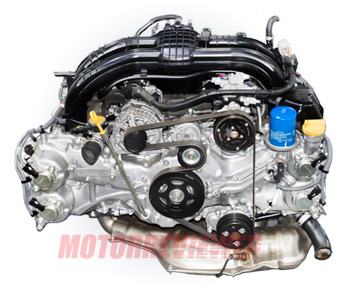Subaru FB20D 2.0L Engine Specs, Problems, Reliability, Info

Subaru FB20D Overview
In 2016, Subaru introduced the new 2.0-liter naturally-aspirated (NA) flat-four gasoline engine with direct fuel injection. This boxer engine, called the FB20D, made its debut in the fifth-generation (2017 model year and later) Subaru Impreza, replacing the previous 2.0-liter engine, the FB20B. The main difference between the two is the direct injection, but there are other differences as well. Let's take a closer look at the design of the FB20D and its variations.
FB20D Engine Design
The new FB20 uses an aluminum open-deck cylinder block with a cooling jacket spacer and cast-iron sleeves, poured into the block during the production process. The engine features forged, lightweight pistons, new piston rings and a higher compression ratio (12.5:1 compared to 10.5:1). The FB20D received new aluminum DOHC heads with direct injectors. Camshafts are driven by chains. The engine uses two single roller timing chains. Both the intake and exhaust camshafts come with a variable valve timing system, Subaru Dual AVCS. The valve train features roller rocker arms and non-hydraulic lifters. The valve covers of FB20D are now made from plastic.
The engine uses a direct fuel injection system: the fuel is injected directly into the combustion chambers through direct injectors installed in the cylinder heads. This system operates with a high fuel pressure supplied by a high-pressure fuel pump located on the left cylinder head. The HP fuel pump is powered by an additional lobe on the intake camshaft. Intake also got some upgrades. There are new plastic intake manifold and tumble generator valves (TGV). Another significant change is the replacement of the traditional mechanical thermostat with a Thermo Control Valve (TCV), which helps to regulate the cooling system more efficiently. The exhaust gas recirculation (EGR) system is now also equipped with water cooling.
Subaru's main goal was to increase engine efficiency and reduce harmful emissions. As a result, the FB20D engine complies with the stricter Euro-6 environmental standards. The power, torque and fuel efficiency have increased slightly, and the numbers are barely noticeable while driving.
FB20D Engine Versions
In 2018, Subaru replaced the FB20X with the FB20D e-Boxer engine in the Subaru XV and Subaru Forester hybrid models. This version has been adapted to work in a mild parallel hybrid configuration. 143 hp (107 kW) at 6,000 rpm and 139 lb-ft (188 Nm) at 4,000 rpm.
The direct-injection 2.0-liter boxer engine called FB20V was also used in the 2019+ Subaru Crosstrek Hybrid (PHEV) with a plug-in hybrid system sourced from Toyota. The FB20V is another detuned version of the conventional FB20D, produced 137 hp (102 kW) and 134 lb-ft (182 Nm).
Engine Specs
Oil recommendations and capacity may vary depending on the car model, year, and market. Please check the service manual specific to your vehicle!
FB20D Engine Problems and Reliability
The previous version of the 2.0-liter FB engine had some reliability issues. Unfortunately, the new model, the FB20D with direct injection, has even more weaknesses:
- The engine consumes oil. There is a problem with the oil rings, which leads to excessive oil consumption as the mileage increases.
- Direct-injected engines experience issues with carbon build-up inside the intake system. The FB20D may require walnut blasting done around 80-100k miles.
- Direct injectors and high-pressure pump are more sensitive to the quality of fuel.
- The TCV (thermo control valve) has been known to have issues.
Summary
So, is the FB20D a good or bad? It is definitely not the most reliable engine out there. They aren’t performance oriented at all, either. It's a modern engine that has enough longevity to last for a regular car. To prolong the life of this engine, use only the recommended engine oil, fill up with premium gas, and service your vehicle properly. The approximate lifespan of FB20D is around 150,000 miles (250,000 km).
